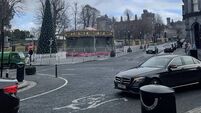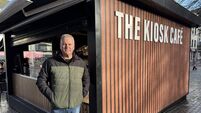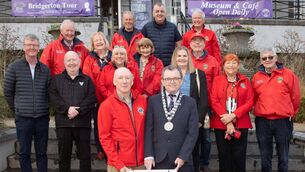Phoenix: How it works

The pedestrianized heart of Waterford city really comes into its own for Spraoi.
As with most people in Waterford, the bank holiday weekend was spent with friends, family and guests from abroad sampling the delights of Spraoi.
Good weather helps enormously, but our lot had a spectacularly good time.
At times like this, while waiting or watching various acts, you find yourself examining things in microscopic detail. You see the nicely presented and the down-at-heel premises around town up close.
A lot of people are really trying and the city looks the better for it.
The pedestrianized heart of the city really comes into its own for Spraoi, although a centrally located hotel, possibly in Michael Street with access to the closed New Street car park, has to be an essential element in any future plans.
The Viking Triangle area was a huge hit, especially Cathedral Square and Constitution Square (behind the Bishop’s Place), and the Church Yard sessions underline what a beautiful venue that Bailey’s New Street is.
Interestingly, Bank Lane and Mall Lane were closed to traffic and were very lively. The area around Reginald’s Tower on the Mall is developing real life of its own. WCQ in O’Connell Street and the Applemarket also drew huge crowds.
The ambition must be to get that level of vitality into the city every weekend to underpin retail, restaurant and night-time activities. The connection through Spring Garden Alley from the Applemarket to the Mall is still terribly prosaic, with shabby sheds lying up against the historic city wall. It’s a no brainer that this link should be beautifully paved and lit.
Having been in and around The Mall on several days recently when the place was absolutely thronged with cruise liner visitors, it’s remarkable that international visitors pay to visit this city while our national image profile, this not being generally considered as a tourist area, is still quite low. We will eventually be an overnight success after 40 years of effort!
The UK NGO Centre for Cities (CfC) has said that its latest analysis of how high streets are doing across 63 UK cities shows that the problems facing struggling high streets are economic, not cosmetic.
Most struggling high streets sit in the middle of low growth, low wage local economies. They say quite categorically: “A struggling high street is the outcome of a struggling economy, not the other way round. So any policy interventions to save the high street shouldn’t start with the high street itself, but the wider economy.”
The UK is not directly comparable to Ireland but it's close enough.
Waterford City is doing quite well, in terms of employment, house building and image building. You can see and feel that around the place. B&Q and IKEA’s arrival were not accidental. The recent designation as the “Best place to live in Ireland” didn’t fall from the skies.
Much good work is going on, but the SEEM report from SETU academics clearly suggests that the local and South East regional economy is lagging. So there is a correlation there.
The CfC also suggests that cities should build on visitor attractions and develop housing in city centre brownfield sites.
Our own council is busy on both fronts, even though the housing element is slow for a variety of reasons.
If any criticism can be made it is that these things seem to proceed at a glacial speed. The lovely buildings on Parade Quay from Bailey’s New Street to Greyfriars had a terrace of really interesting and attractive small shops, which were closed and decanted from the area to facilitate development nearly a year ago, but still nothing has happened. This is really unhelpful to the wider effort being made.
A philosopher might tell you that everything is connected to everything else. When you think about things in Ireland, you realise that politics and political ambition are everywhere. Most people don’t even think about it, but it’s everywhere.
Every move in Ireland is a chess game driven by political influence. Sure, we have National Development Plans and the like, which tell us how the country will (hopefully) develop over the coming decade, but only the extremely foolish would expect things to happen in Waterford without political wind behind them. We saw that most clearly during the ministerial career of Martin Cullen from 1997 to 2010. Not all of our or his ambitions were achieved, but the retrospective scorecard is quite impressive and it galvanized private investment in the local economy.
The development of the M9 to Dublin has transformed this area. It has exposed Waterford city to a level of regional and national competition that the previously vile N9 roadway protected us from. A four-hour journey to Dublin by car imposed its own barrier to trade. It’s now a case of compete or die.
Across every metric, from retail to education and medicine, people now have access to choice in a way that previous generations would have thought to be impossible. The very fact that a Waterford family can choose to leave here at 8.30am on Saturday and be in Dublin shortly after 10.00am for retail therapy or entertainment amply demonstrates the point.
Our local economy needs state investment, like the North Quays, as seed capital, if the city is to retain its place in the Irish urban rankings, attract private investment and function as the regional centre for the South East. It also needs adequate care of private property.
In this regard, the rear of the “new” buildings in Railway Square are terrible. The upper floors of TK Maxx and Odeon Cinema are truly grimy and dreadful. The Link Road between Manor Street and Bath Street brings thousands of people past this building. Heaven only knows what they make of it. The owners are doing a disservice to Waterford.
The 33-year-long history of Spraoi is a real metaphor for the huge effort required to develop and establish a reputation in the Irish cultural landscape. While it benefits from state funding, I bet that the sums involved fall far short of funding for the Galway or Kilkenny arts weeks. As with our airport, we end up having to find a lot of development funding within the local community.






